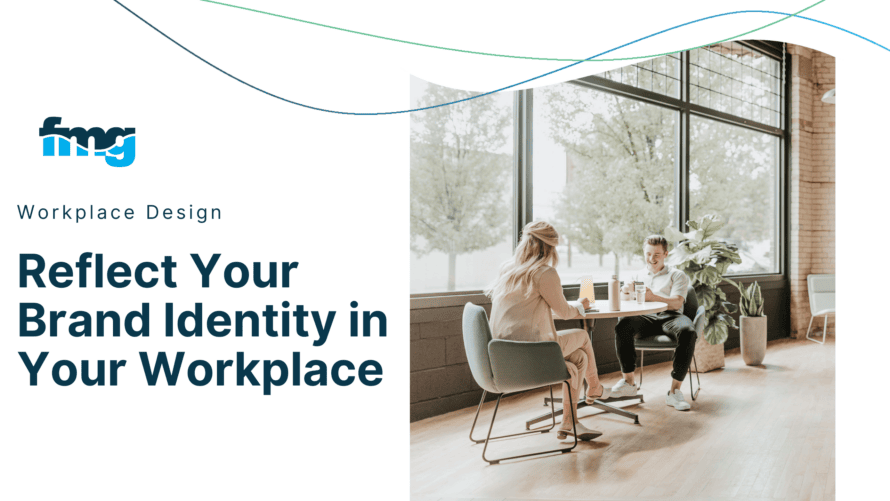In today’s competitive market, office design is no longer just about aesthetics; it’s a strategic tool to reflect and reinforce your brand identity.
For C-suite executives, marketing directors, and architects, the challenge is to seamlessly infuse corporate values and ethos into the workspace, creating an environment that resonates with employees and clients alike. A well-thought-out office design not only enhances productivity but also serves as a constant reminder of the company’s mission and vision.
In this article, we’ll explore how to effectively align your office space with your brand identity, ensuring your workspace is seen and felt.
Key Takeaways
- Brand Identity Integration: Your office design is more than decor—it’s a narrative of your brand’s values and vision. Let your workspace echo the essence of your brand identity.
- Consistency is Key: Ensure every design choice, from color schemes to materials, consistently reflects your brand. Consistent design builds strong recognition and trust.
- Functional Design: Craft spaces that are not only visually appealing but also enhance productivity and efficiency. Flexible layouts can cater to diverse working styles and needs.
- Technological Edge: Embrace advanced technologies to create a forward-thinking workspace that supports innovation and future readiness.
- Storytelling Through Space: Use your office environment as a storytelling tool. Make it a space that inspires both employees and visitors, reflecting your brand’s journey and aspirations.
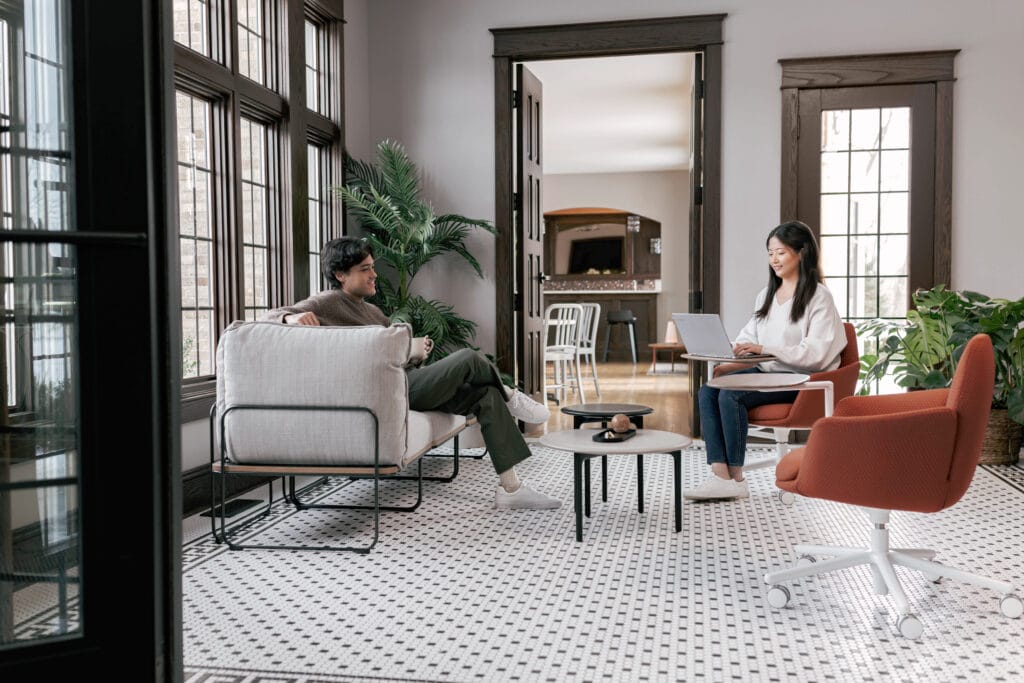
Defining Brand Identity in Design
Brand identity in design goes beyond logos and color schemes; it’s about creating a space that embodies the essence of your brand. It includes the company’s values, mission, and the emotional resonance it aims to create. Each element of your office should be a representation of this narrative. Each decision should reflect the brand’s core attributes, from choosing the right furniture that promotes collaboration to the color palette that sets the mood.
For instance, a tech startup might prioritize innovation and flexibility, opting for open spaces and modular furniture. On the other hand, a law firm may focus on professionalism and trust, using more traditional layouts and muted colors. By clearly defining what your brand stands for, you can ensure that these elements are consistently applied, creating an environment where employees and visitors can intuitively understand your brand’s identity.
Importance of Consistent Branding
Consistent branding in office design is crucial for reinforcing your company’s values and creating a cohesive brand image. When your workspace’s visual and physical elements align with your brand identity, it creates a unified experience for everyone who interacts with it. Consistency helps build brand recognition, making it easier for visitors and employees to connect the workplace with the brand’s ethos. It also instills a sense of pride and belonging among employees as they see the brand’s values reflected in their everyday environment.
This consistency should extend beyond just visual elements; it should also be evident in the functionality and layout of the space. For instance, a brand that values sustainability should integrate eco-friendly materials and practices throughout the office. Maintaining consistency ensures that every aspect of your office design contributes to a strong, memorable brand identity.
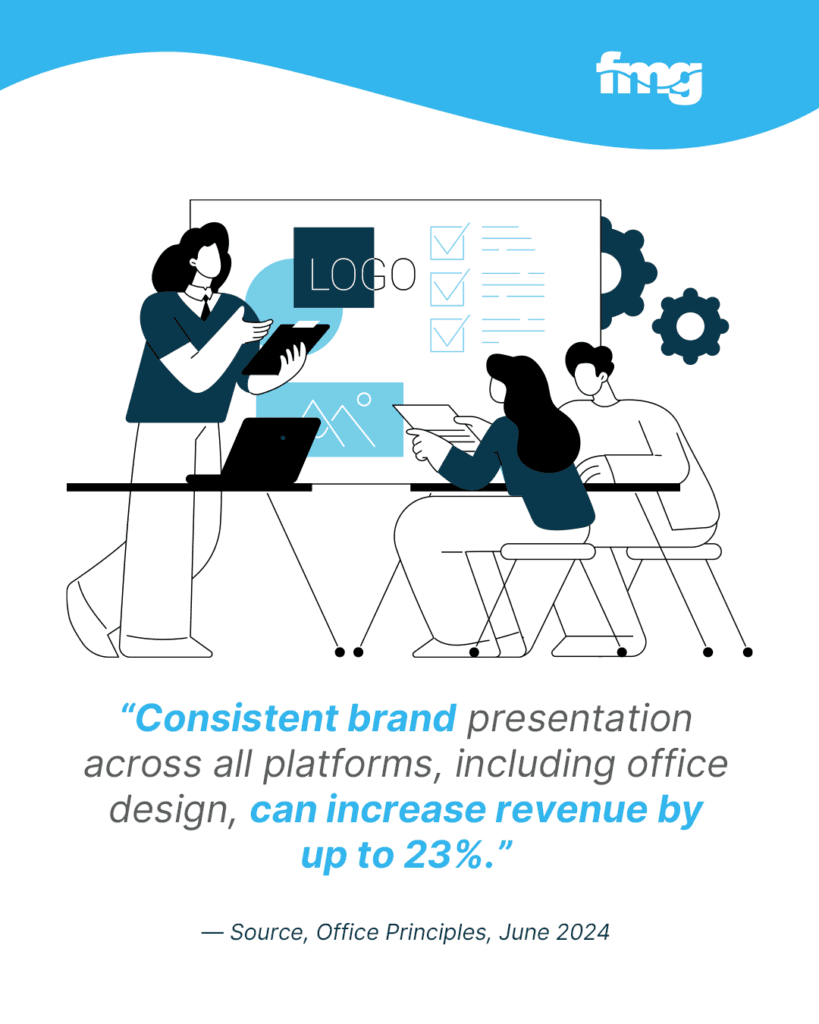
Aligning Design with Brand Values
Aligning your office design with brand values ensures that your workspace is functional and reflects what your company stands for. This alignment starts with a deep understanding of your core values—whether they emphasize innovation, sustainability, collaboration, or customer-centricity. For instance, a company that prides itself on sustainability might incorporate green spaces, use recycled materials, and ensure energy-efficient lighting. Similarly, brands focused on innovation may design open, flexible spaces that encourage creativity and interaction.
Every element, from the choice of furniture to the layout, should echo these values. This thoughtful integration creates an environment where employees feel connected to the brand’s mission, fostering a sense of purpose and belonging. Moreover, it sends a clear message to clients and visitors about what your company prioritizes. You visually represent your company’s ethos by embedding brand values into the physical space.
Colors and Materials
In contrast, sleek metals and glass might represent a brand’s modernity and technological focus. By thoughtfully selecting colors and materials that reflect your brand’s essence, you create an inviting and functional workspace and subtly reinforce your brand message with every interaction. This approach ensures that every element of your office is a testament to your brand’s identity.
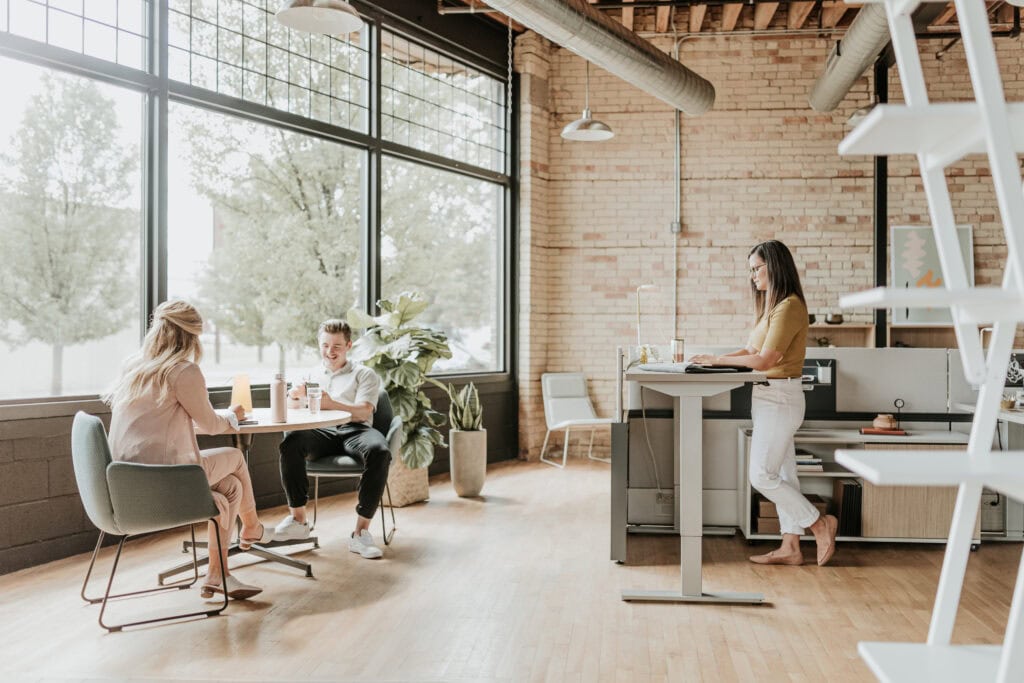
Layout and Functionality
The layout and functionality of an office are integral to how effectively it supports your brand’s operations and culture. An open-plan layout can foster collaboration and transparency, aligning well with brands that value teamwork and open communication. Conversely, companies prioritizing confidentiality and focus might benefit from private offices or strategic partitioning. The functionality of the space should also cater to the specific needs of your business.
Creative industries might incorporate flexible work zones and brainstorming areas, while tech companies might need dedicated spaces for high-tech equipment and infrastructure. Ergonomic furniture and well-designed workstations are essential for employee well-being and productivity, reflecting a brand’s commitment to its team. By aligning the office layout with the functional needs of the business and the values it stands for, you create a workspace that looks good and enhances efficiency and satisfaction.
Technology and Innovation
Incorporating technology and innovation into office design is essential for modern brands seeking to stay ahead of the curve. The integration of advanced tech solutions not only enhances productivity but also reflects a brand’s commitment to innovation. Consider smart office technologies like automated lighting, climate control, and high-speed connectivity, which streamline operations and improve employee satisfaction. Meeting rooms equipped with state-of-the-art video conferencing tools enable seamless communication across global teams, reinforcing a brand’s forward-thinking approach.
“Among the top 100 global brands, Tesla has experienced the highest value gain, currently valued at $66.2 billion, showcasing the impact of innovation on brand value.” — Source, G2 Learning, October 2023
Furthermore, interactive displays or digital signage can make information sharing efficient and dynamic, appealing to tech-savvy employees and visitors. Innovative design elements, such as modular furniture systems, can adapt to changing needs, highlighting a brand’s flexibility and ingenuity. By embedding these technological advancements into your office design, you create an environment that supports current operations and anticipates future demands.
Executive Office Considerations
Designing office spaces for C-suite executives requires a balance of functionality, privacy, and brand representation. Executive offices should be tailored to support these leaders’ decision-making and strategic planning roles. Privacy is often paramount, necessitating soundproofing and secure communication systems. The layout should facilitate focus and concentration while allowing spontaneous meetings and collaborations. Incorporating high-quality materials and finishes reflects the brand’s prestige and aligns with the executive’s status within the organization.
Additionally, technology integration is crucial; executive offices should be equipped with the latest tools for seamless connectivity and productivity. Personalization elements, such as artwork or mementos, can create an inspiring environment that resonates with the executive’s style and the company’s culture. By thoughtfully considering these aspects, you create a space that empowers executives to lead effectively while embodying the brand’s identity.
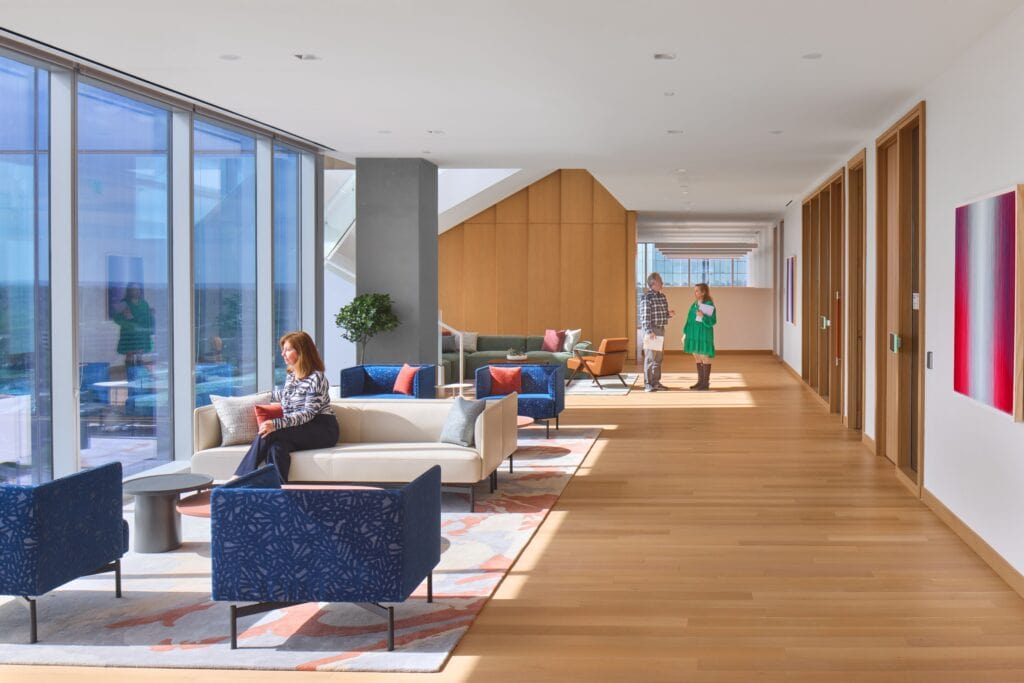
Creating Inspirational Spaces
Inspirational spaces for C-suite executives are essential for fostering creativity and strategic thinking. Such environments should stimulate innovation while providing a serene retreat for reflection and planning. Incorporating natural elements, like plants or water features, can create a calming atmosphere, reducing stress and enhancing focus. Artwork that resonates with the company’s mission or the executive’s interests can be a source of inspiration.
Flexible seating arrangements and modular furniture allow for adaptability, enabling executives to switch between focused work and collaborative discussions effortlessly. Lighting plays a pivotal role; adjustable fixtures can provide the right ambiance for different tasks, from bright lights for focus to softer tones for contemplation. Designing an inspiring office enables executives to approach challenges creatively and confidently, ultimately driving the brand forward. Such spaces are functional and a testament to the company’s commitment to leadership and vision.
Balancing Privacy and Collaboration
Balancing privacy and collaboration in executive office design is crucial for meeting the diverse needs of C-suite roles. Executives often require quiet, private spaces for confidential discussions and focused work. This necessitates soundproofed offices and secure communication technologies to ensure discretion. At the same time, executives must remain accessible to their teams for collaboration and leadership.
Design solutions such as glass walls with privacy films or retractable partitions can offer flexibility between openness and seclusion. Comfortable seating and meeting areas within the office allow for impromptu discussions without sacrificing privacy. The strategic layout facilitates solitude and interaction, with spaces designated for individual tasks and group engagements. By carefully crafting environments that support privacy and collaboration, you empower executives to lead effectively, fostering a culture of transparency and teamwork while maintaining the confidentiality necessary for their role.
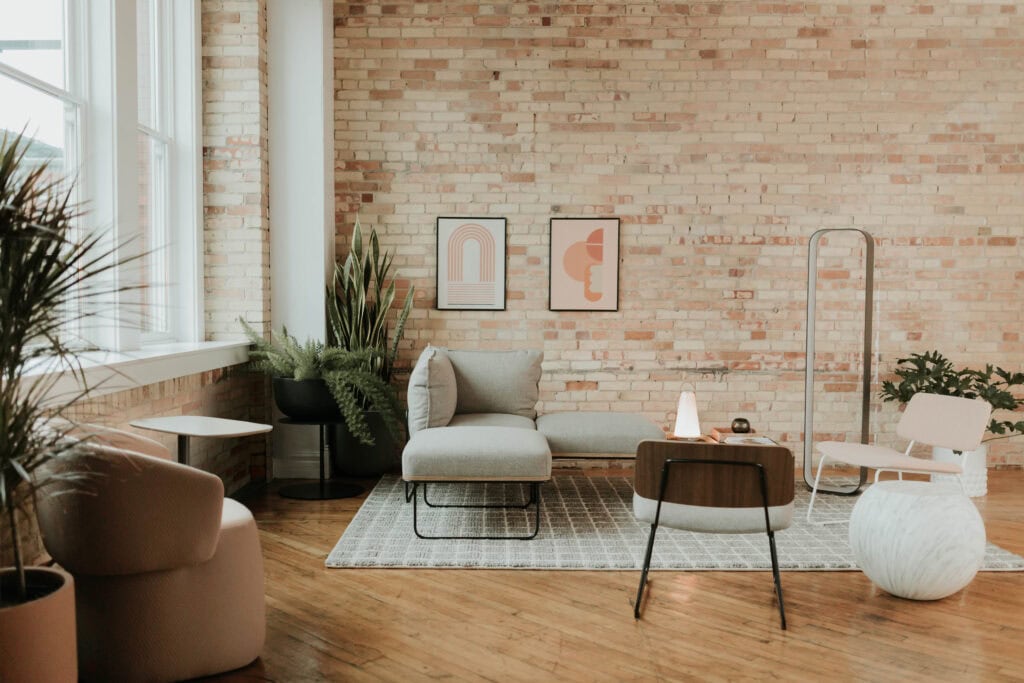
Boosting Morale with Design
Office design significantly influences employee morale, impacting productivity and job satisfaction. A well-designed workspace inspires and motivates employees, making them feel valued and engaged. Natural light, ergonomic furniture, and vibrant color schemes can create an uplifting atmosphere. Spaces encouraging social interaction, such as communal kitchens or lounge areas, foster community and collaboration. Personalization options, like adjustable desks or personalized decor, allow employees to adapt their space to their needs, promoting comfort and ownership.
Additionally, including wellness features such as quiet zones for relaxation or fitness areas can contribute to overall well-being. By prioritizing design elements that enhance the work environment, companies show their commitment to employee satisfaction, which can lead to increased retention and a more positive workplace culture. A thoughtfully designed office becomes a powerful tool in boosting morale and fostering a thriving work environment.
Enhancing Productivity through Space
The layout and design of an office play a pivotal role in boosting employee productivity. A thoughtfully arranged workspace minimizes distractions and streamlines operations, allowing employees to focus on tasks. Open spaces encourage collaboration and communication, while quiet zones or private pods offer retreats for concentrated work. Ergonomically designed workstations reduce physical strain, leading to better focus and efficiency. Incorporating technology seamlessly into the workspace ensures that employees have the tools they need, which can significantly enhance productivity. The use of natural light not only improves mood but also reduces eye strain, contributing to a healthier work environment. Flexible spaces that can be adapted for various purposes—such as meetings, brainstorming sessions, or relaxation—cater to different working styles and needs. Companies can foster an atmosphere where productivity thrives by creating an environment that supports diverse activities and work modes.

Reflecting Company Culture
Office design is a powerful medium for reflecting and reinforcing company culture. The physical environment can embody the organization’s values, ethos, and vision, making them tangible for employees. A company that values innovation might opt for open, collaborative spaces encouraging spontaneous interactions and idea-sharing. In contrast, a firm emphasizing tradition and stability may choose more formal and structured layouts. Incorporating cultural elements, such as artwork reflecting the company’s history or mission-driven decor, fortifies this connection.
Spaces for team-building activities or areas celebrating employee achievements can also highlight a culture of recognition and camaraderie. By aligning the design with company culture, employees are more likely to feel connected to the organization’s goals, enhancing engagement and loyalty. This reflection of culture in the workspace fosters a strong, unified identity, making it clear to employees and visitors what the company stands for.
Innovative Office Transformations
Innovative office transformations can serve as inspiring examples of how design can revolutionize a workspace. Consider a tech company transitioning from a traditional office setup to a flexible, open-plan design, integrating modular furniture and collaborative zones. This change improved communication and significantly boosted team innovation and morale.
Another case might involve a creative agency that embraced biophilic design, introducing natural elements like indoor greenery and abundant natural light. These changes created a more serene and energizing environment, increasing employee well-being and productivity. Retail brands have also successfully used design to reflect their identity, using bold colors and custom installations to create immersive brand experiences within their offices.
Businesses can glean insights into how strategic design can enhance work culture and employee satisfaction and ultimately drive business success by analyzing these transformations.
Lessons from Leading Brands
Leading brands offer valuable insights into the impact of strategic office design on organizational success. Take, for example, Google’s offices, which prioritize creativity and flexibility with vibrant, open spaces and unique breakout areas. This design fosters innovation and collaboration, aligning with the company’s forward-thinking ethos.
Similarly, Apple’s sleek, minimalist office design reflects its brand values of simplicity and precision, creating an environment that inspires focus and excellence. These examples show how office design can be a powerful tool for communicating brand identity and boosting employee engagement.
Moreover, brands like Airbnb have successfully integrated local culture into their office spaces, creating a sense of connection and community among employees. These lessons highlight the importance of aligning office design with brand values, using space to inspire and engage, and thoughtfully incorporating elements that resonate with employees and visitors alike. By following these principles, companies can create dynamic and meaningful work environments.
Create Spaces That Tell Your Story
Are you ready to transform your office into a dynamic, hybrid workplace that elevates trust, collaboration, and well-being? With our expertise in incorporating innovative design elements, ergonomic solutions, and cutting-edge technologies, we ensure your workspace eloquently communicates your unique brand story while enhancing productivity and employee satisfaction.
Contact us today to embark on your path toward a more resilient and adaptable workplace. Together, we can craft environments that empower your team to thrive, regardless of their location. Let’s shape the future of work, one creative space at a time.
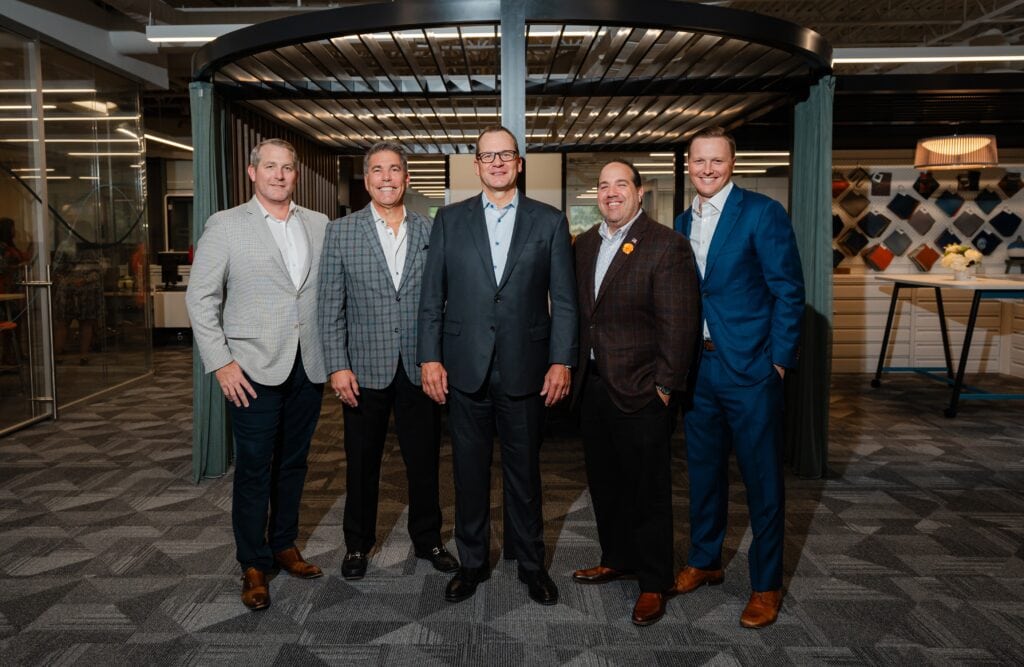
About FMG
FMG specializes in designing and executing comprehensive workplace solutions. As a “Best In Class Dealer,” FMG partners strategically with Haworth Inc., a global leader in producing commercial office furniture, offering movable walls, systems furniture, seating, storage, and more.
FMG’s commitment extends beyond providing top-tier furniture and architectural products. Our company ethos is built on values that prioritize our clients, treating them like family and fostering trust through outstanding service.


